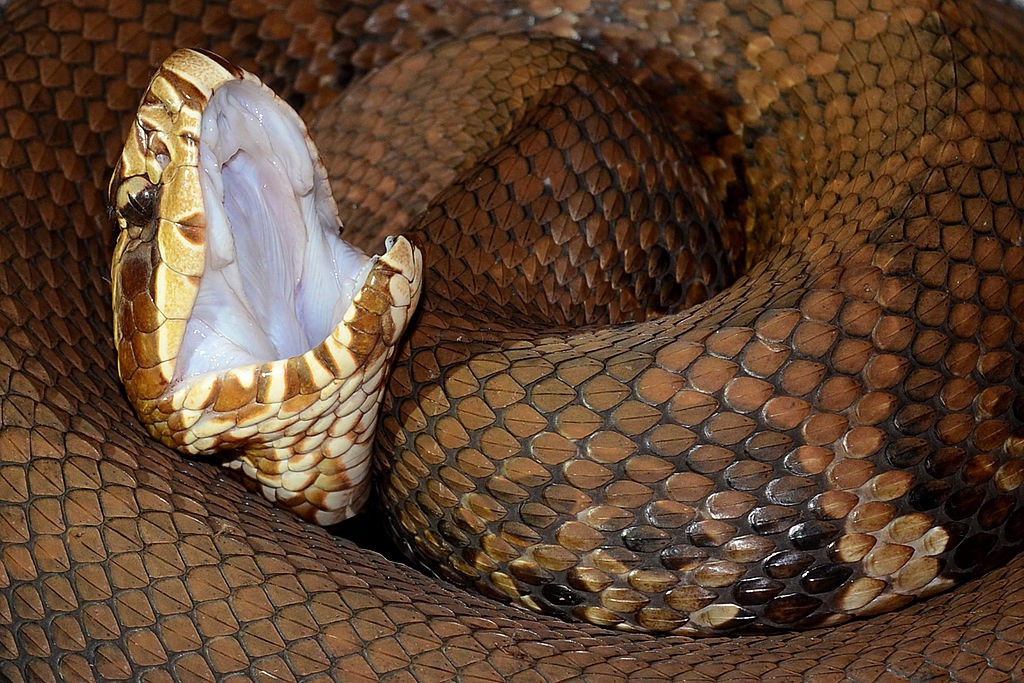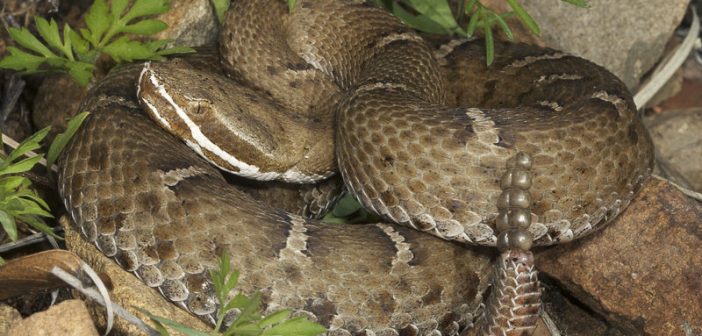Venomous (poisonous)1 snakes can be problematic anywhere, especially in a yard. The good news is that research shows that native venomous species in the United States prefer not to bite and aren’t aggressive unless provoked. And, when they do bite a human, their venom rarely kills. With watchfulness when outdoors, one can live around them safely. The best way to coexist is to keep them at a distance. Here are tips on how to do that.
Keeping snakes away
Many elements that attract other wildlife to our yard—woodpile, brush pile, rock pile, trees, tall grasses, bushy shrubs, and water—are good hiding and hunting places for snakes because they don’t like to be seen.
So, if venomous species live in your area,2 keep your yard trimmed and tidy. This means no messy areas, grasses mowed short, and shrubs trimmed above ground level, particularly around your house. Also, remove the above attractments or relocate them to the perimeter of your yard.
You may wonder if that doesn’t defeat the purpose of creating a wildlife habitat. Well, yes and no. It does mean you need to plant your wildlife areas away from your house and areas you use for playing and entertaining. But you can still have wildlife habitat; just put it farther away, like along the perimeter or in corners.
One homeowner has reported to us that she lives in a rural Florida area that’s heavily wooded and has thick undergrowth that harbors venomous snakes. She keeps her yard cleared except for the perimeter, where she can enjoy watching wildlife with safety. She rarely sees a snake, but when she does, they’re always just barely visible in the undergrowth, only their movements catching her attention. If she approaches, the snake disappears. In her twenty-three years there, she’s never seen one come into the open where it would be fully exposed.
Another thing you can try is a snake repellent. One of them, available on the internet and possibly in sporting goods stores, is Dr. T’s Snake-A-Way repellent, which has been university-tested and used by the U.S. military. It’s safe for the environment, animals, and humans. It doesn’t hurt snakes, either—it works by temporarily shutting down the Jacobson’s organ, which unsettles snakes and scares them away from the area. (The Jacobson’s organ is located on the roof of the snake’s mouth, where our soft palate would be. This organ has chemical receptors that are each specialized to receive only a specific type of chemical. You can read more about it on the All about snakes page.
It may be reassuring to know that in the U.S., nonvenomous snakes outnumber venomous ones in both the number of species and number of individuals. Out of about 120 snake species in the U.S., there are only about twenty species and subspecies of venomous ones: rattlesnakes, cottonmouths, copperheads, and the rarely found coral snakes. Every state but Alaska and Hawaii is home to at least one venomous species. The highest concentrations are in warm states.

Cottonmouth, Agkistrodon piscivorus, exposing the inspiration for its name. Though considered the most aggressive venomous snake in the U.S., they actually don’t bite unless stepped on or attacked.3 (Geoff Gallice / Wiki; CC BY-SA 2.0)
No U.S. snakes are aggressive toward humans. They won’t approach you; you must approach them. If you accidentally encounter one, venomous or not, stay calm and slowly back away. You want to avoid inadvertently cornering a snake, leaving it no choice but to strike. Snakes can spring forward about half their body length, so a snake that’s four feet long (1.2 m) can spring roughly two feet (0.6 m) toward you.
By the way, it’s well known that rattlesnakes shake their tail and make a distinctive sound, but other snakes shake their tail, too. If a harmless one happens to shake its tail against dry grass or leaves, it might sound something like a rattle. (The rattlesnake’s “rattle” is caused by hard segments of its tail rubbing together when it shakes it.)
According to the U.S. Centers for Disease Control and Prevention, about 7,000 to 10,000 people are bitten by venomous snakes each year in the U.S., and ten to fifteen die. Although some bites occur when a snake in hiding is stepped on or cornered, almost all bites happen to someone trying to catch or kill one.
A venomous snake’s bite is its last resort because it’s stingy with its venom—once it’s used up, it has no defense. It’s probably for this reason that in 25 to 30 percent of bite cases, venom isn’t injected at all.
About venom
Venom is a modified saliva made up of different proteins and enzymes and must be injected to be harmful. (If we were to drink venom, it wouldn’t be toxic.) The kind of toxin a venomous snake carries varies with the species and works in one or more of the following ways: as a neurotoxin, which affects the nerve centers and can lead to asphyxiation; a cardiotoxin, which affects muscles and can stop the heart from beating; or a hemotoxin, which affects blood vessels, causing severe bleeding.
How to treat a snake bite4,5
- Remove any jewelry, watches, or tight clothing before swelling starts.
- Don’t put ice on the wound; it can be harmful.
- Don’t use a tourniquet; it can cause loss of the entire limb.
- Don’t cut the wound or try to remove venom; it can cause more harm than good.
- Clean the bite with soap and water. Wrap a bandage two to four inches above the bite to slow the venom, but not so tight as to cut off blood flow; be able to slip a finger under it.
- Sit or lie down so that the bite is in a neutral, comfortable position.
- Immobilize the affected area.
- Keep the bitten area lower than the heart.
- Call 911 or go immediately to an emergency room.
- Try placing a suction cup over the bite to help draw venom out of the wound; don’t use your mouth.
- Don’t drink caffeine or alcohol.
- Don’t take pain-relieving medicine, such as aspirin, ibuprofen (Advil, Motrin IB, others), or naproxen sodium (Aleve). Doing so can increase your risk of bleeding.
Don’t try to catch or trap the snake. Try to remember its color and shape so that you can describe it. If possible, take a picture of the snake from a safe distance. Knowing what kind of snake bit you can help with treatment.
| 1 The terms venomous and poisonous are often used interchangeably. However, venomous is the correct term for snakes. The difference is that venom is injected into a body, and poisons enter by other means, such as through the skin or swallowing. |
| 2 Find out if venomous snakes live in your area by contacting your state’s Wildlife and Parks Department. |
| 3 Kimberly Andrews, “Cottonmouth / Water Moccasin (Agkistrodon piscivorus),” Savannah River Ecology Laboratory, University of Georgia, https://bit.ly/3uJvHWe. |
| 4 Mayo Clinic Staff, “Snakebites: First aid,” Mayo Clinic, https://bit.ly/3t04COb. |
| 5 American Red Cross First Aid/CPR/AED Participant’s Manual, pages 95-96, https://bit.ly/3N2U5sk. |
All about snakes
Special topics
For this snake, ‘rough’ takes on new meaning






